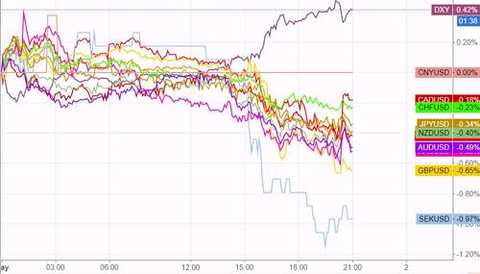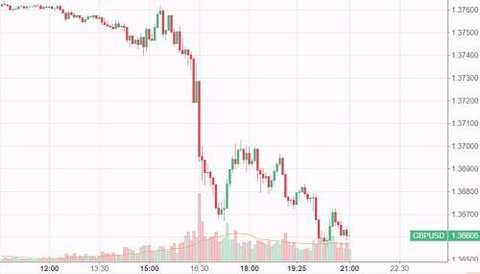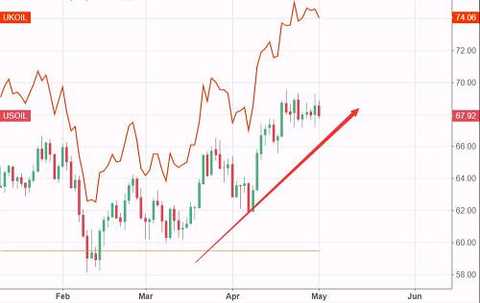After Monday’s rally, the US dollar index’s gains continued on Tuesday (May 1st), hitting a high of 92.32, and brushing the highest level in three and a half months. Non-US currencies have again experienced different degrees of decline. At present, the US dollar index has completely recovered the lost land during the year and has risen 3.2% in the past two weeks. In the evening, the Bank of Canada central bank governor will speak, investors can pay attention to the situation of the Canadian dollar. ING said that the trading volume became scarce during the May 1st Labor Day holiday. In general, high-yield currencies would perform better. In the G10 currency, the US dollar performed even stronger. The three-month LIBOR rate for the US dollar is close to 2.35%. US President Trump previously seemed to have avoided a trade war with the EU because the United States extended the time limit for tariff reductions. Later in the day, the US ISM manufacturing PMI will be announced in April, and it is expected to be at a high level. The market will focus on the price payment index, which recently recorded its highest level since the beginning of 2011. In the short term, the US dollar is strong, and the US dollar index DXY looks at 92.5. Trade friction continues China and the United States will hold trade talks on Thursday and Friday. The US has already announced the departure of representatives to China for trade talks on May 3. The personnel situation is as follows: US Ambassador to China Terry Branstad; US Treasury Secretary Steven Mnuchin US Secretary of Commerce Wilbur Ross; US Trade Representative Robert Lighthizer; Larry Kudlow, director of the National Economic Council; Peter Navarro, White House Trade Consultant; Everett Eissenstat, Associate Advisor to the US President for International Economic Affairs The three major Chinese hawk missions, Liteshze, Navarro and Kudlow, are listed. Although Kudlow is a supporter of free trade, he has a tough attitude toward China. He claims that the root cause of the trade conflict between China and the United States is that China does not comply with trade rules. According to the New York Times, during the US trade mission to Beijing this week, the Chinese side will refuse to consider Trump's two toughest trade requirements. The report said that after Trump proposed to impose tariffs on goods worth 150 billion U.S. dollars imported from China, senior Chinese officials were not interested in discussing Trump’s annual trade deficit reduction of US$100 billion against China and banned Chinese investment in artificial intelligence. And the requirements of "sensitive" technologies such as electric vehicles. At the same time, trade frictions between the United States and the European Union continue. According to the Wall Street Journal, Trump will postpone the decision on steel and aluminum tariff exemptions for other US allies such as the European Union until June 1. The Speaker of the European Parliament, Tayani, said that it is not enough for the United States to extend the tariff exemption to the EU until June 1. A French government spokesperson immediately said that France supports the EU's position on the issue of extending tariff decisions in the United States. France will continue to insist that the EU should obtain a permanent and unconditional full exemption on the tariff issue. The US unilaterally raise tariffs is unfounded. There is indeed a problem of overcapacity in the steel and aluminum industry. France is ready to discuss this with the United States, but first it needs to determine that the EU is not affected by tariff increases. The German economy minister said that global trade needs to reduce taxes rather than increase. Another data is not ideal due to the question of Brexit, the pound will brush for three and a half months. After last week's poor GDP data, the UK's manufacturing PMI data released today also hit a one-and-a-half-year low, the market's expectation of a rate hike by the Bank of England plummeted, plus between UK and US Treasury bonds. The spread of the spread and the issue of Brexit, the pound seems to be facing a very strong downward pressure. UK manufacturing PMI 53.9 in April was the lowest since November 2016, with an expected 54.8, and the previous value of 55.1 was revised to 54.9. After the data was released, the pound fell below the 1.37 mark, and the lowest approached 1.3650. The pound is still at a low level. In the case of Brexit, the British Prime Minister’s spokesperson said that the cabinet was disappointed that the House of Lords voted to pass the Brexit amendment and to pass the Brexit decision to the parliament. The Prime Minister believes that the key to this set of bills should be to ensure the smooth exit of Brexit. British Trade Minister Fox said that the opposition party members are trying to obstruct the will of the people on the issue of Brexit. The crude oil market is not too flat. In addition to the gradual balance of crude oil market supply, the Iranian nuclear agreement seems to be in jeopardy. Germany, France and Britain are trying to rescue together, but the rescue has not yet been completed, and the Middle East is not even flat. In July 2015, Iran and the six nuclear powers (United States, Britain, France, Russia, China and Germany) reached a comprehensive Iranian nuclear issue. According to the agreement, Iran has pledged to limit its nuclear program while enjoying the right to peaceful use of nuclear energy, and the international community has lifted sanctions against Iran. On January 12 this year, US President Trump announced the last extension of the sanctions exemption for the Iranian nuclear issue, and asked Congress and European countries to agree to amend the terms of the agreement, otherwise the United States will immediately withdraw from the agreement. So the French, German, and British countries quickly contacted the United States and maintained the Iranian nuclear agreement. The British side stated that the unity of the three countries "will play a decisive role in safeguarding our interests and security." Goldman Sachs said it expects oil prices to be around $70/barrel in 2019. As the probability of OPEC extending the production reduction agreement to 2019 has increased, it is expected that there will be significant upside risks to oil prices next year. It is also worth noting that rising oil prices will help push up inflation and may further push the Fed to raise interest rates. At present, the market generally expects the Fed to raise interest rates three times during the year, and does not rule out the possibility of raising interest rates four times. However, the British Petroleum CFO said that BP currently maintains oil price expectations of $50 to $60/barrel during the year. US shale oil production will increase by 100 to 1.5 million barrels per day this year. As shale oil production rises, oil prices will fall in the second half of this year. The best contribution of the Reserve Bank of Australia is to stand still? The Australian market seems to be also a small assist in the US dollar, the Reserve Bank of Australia continues to maintain interest rates unchanged, and said that the appreciation of the Australian dollar will drag economic growth. However, the Australian dollar did not respond much to this. The Reserve Bank of Australia maintained its policy rate unchanged at 1.5%, in line with expectations. The Reserve Bank of Australia said that low interest rates will provide support for the Australian economy and that the economy is expected to grow faster than the same period last year. Unemployment rate and inflation are expected to continue to improve gradually. Maintaining policy stability is consistent with growth and inflation goals. It is expected that the GDP growth rate will be slightly over 3% in 2018 and 2019, and the CPI is expected to exceed 2% in 2018. Inflation will remain low for a period of time, and inflation is expected to gradually pick up as the economy strengthens. The Reserve Bank of Australia said that the appreciation of the Australian dollar will drag down economic growth. The Reserve Bank of Australia said that household consumption is still one of the sources of uncertainty in the outlook. The housing market in Sydney and Melbourne has cooled. The tightening of bank supervision has also played a role in curbing the risk of the property market. A variety of forward-looking indicators indicate that employment will achieve steady growth. Salary growth is still slow and is likely to continue for some time. The Reserve Bank of Australia said that the global economy has increased in the past year. It is expected that Australia's foreign trade will decline compared to the past few years, but it remains at a relatively high level. Reserve Bank of Australia Chairman Lowe said that members again agreed to lack a strong basis for adjusting interest rates in the short term. The next adjustment has reasonable grounds to believe that it will raise interest rates. It is expected that economic growth will be slightly above 3% this year and next, and inflation will rebound towards 2.5% in the next few years. The salary growth rate has bottomed out and is expected to gradually pick up. Only the accelerated growth of wages will bring inflation to the midpoint of the target range. It is expected that the unemployment rate will further decline moderately in the future. Reserve Bank of Australia Chairman Lowe said the committee discussed the rise in dollar financing costs and the impact on the domestic lending market. Public scrutiny of local banks must be translated into incentives to tighten lending standards. US trade protectionism is a risk to economic growth. In summary, the best contribution that the RBA can do now is to keep interest rates unchanged and act as stabilizers. This article was first published on the WeChat public account: Eyes. The content of the article belongs to the author's personal opinion and does not represent the position of Hexun.com. Investors should act accordingly, at their own risk. (Editor: Ji Liya HN003)
Kimono can make you look elegant, dignified, and mysterious, and it can also show your figure and temperament. Our kimonos come in a variety of colors, including black, rose gold, and more. Our kimonos also come in different styles, formal, casual, modern, etc. You can choose the right kimono according to your preferences and occasions, so that you will be full of style when you sleep or participate in activities.
Other product recommendations, such as Swimsuit and Night-out Clothing, etc. Kimonos for Women,Sexy Kimono,Modern Kimonos,Sexy Women Kimonos FOSHANSHI NANHAI KAISIWA NEIYI CO.,LTD. , https://www.loveyousexy-lingerie.com
In addition to the previous US dollar debt, recent external factors seem to be continually boosting the dollar's gains. The UK data is not ideal in the near future. The probability of the Bank of England raising interest rates is declining. The Brexit seems to have some problems again. At the same time, the continuous rise in crude oil prices pushed up inflation, which is also beneficial to the US dollar. 
At the same time, the 10-year UK government bond and US Treasury bond spreads once expanded to 153.5 basis points, a 34-year high. 
Yemen’s armed forces have said that they will launch more rockets, attack Saudi Arabia’s important oil facilities, and claim that they are building their own ballistic missiles. However, Saudi Arabia believes that the Houthi armed ballistic missiles are from Iran.